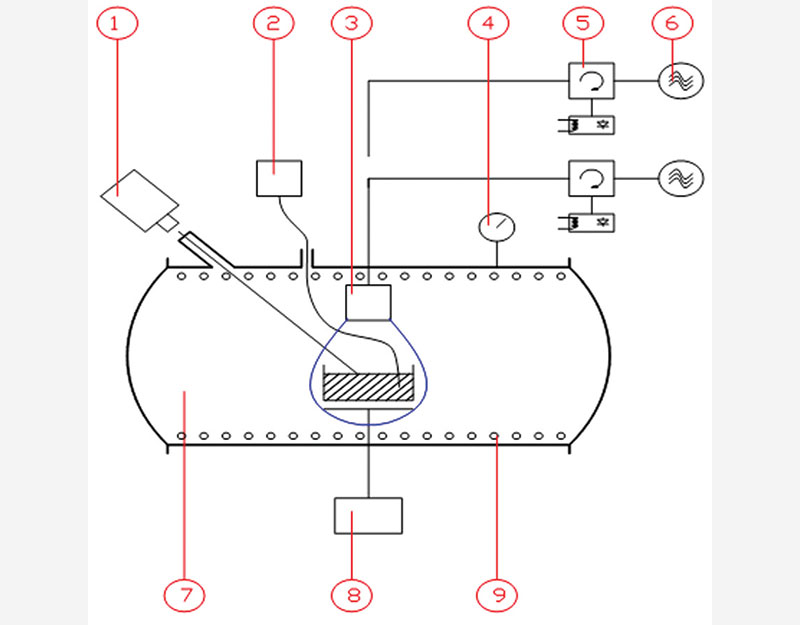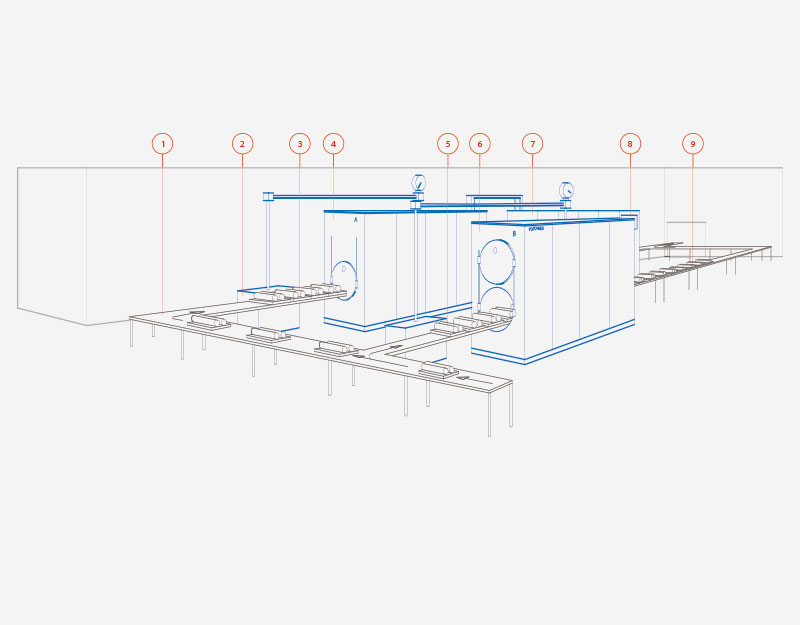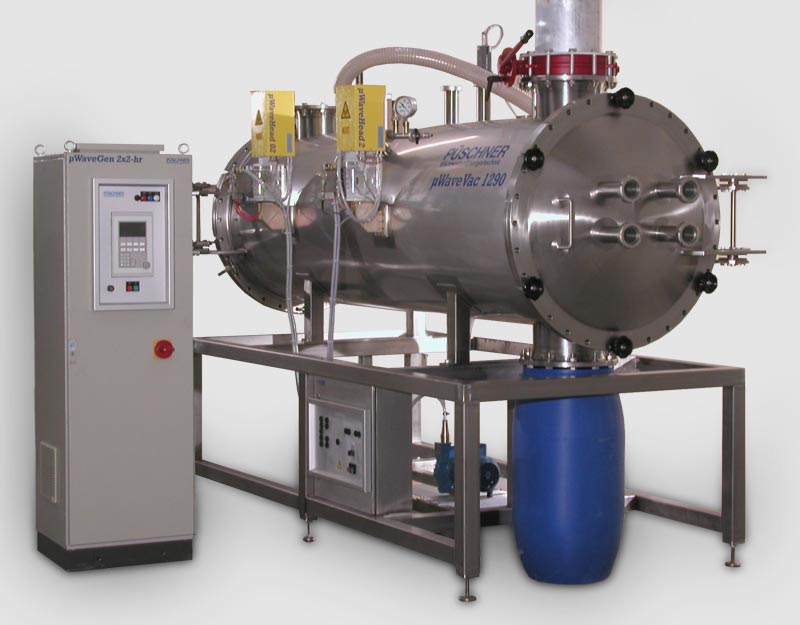Püschner Vacuum Drying / Freeze-Drying
Processing of thermosensitive Materials under Vacuum or/and special Gas Atmospheres
The demands for producing with higher product qualities in shorter drying times for temperature sensitive products can be met by using microwave heat treatment in combination with vacuum drying. Microwave drying has a big advantage compared with conventional drying, because in microwave drying, heat is generated by directly transforming the electromagnetic energy into kinetic molecular energy; thus the heat is generated deep within the material to be dried.
Especially in microwave vacuum drying this advantage has a big significance for viscous and bulk products with poor thermal conductivity. By using appropriate process control even applications with explosive protection can be managed.
Within a continuous production line, the group of continuous working microwave vacuum plants can be incorporated when processing granular, powders as well as bulk materials and solid products on tool carriers.
Application Examples - Püschner Batch Vacuum Dryer
Process Investigations Using an Universal and Modulare Microwave Vacuum Batch Plant
In order to find the optimal settings for a microwave production vacuum process, the trial plant shown in figure 1 can be used for process investigations. The microwave vacuum system can be equipped with different applicators and antenna systems. By using an infrared and fibre-optical temperature measurement system, core and surface temperatures can be measured. In addition weight loss, pressure and the absorbed microwave energy can be measured as well.
Legends:
1) Pyrometer (0..1000°C)
2) Fibre-optical temperature measurement system
3) Microwave antenna
4) Pressure measurement
5) Circulator (magnetron protection) incl. Measurement of the reflected power
6) 1.2kW/2450MHz Magnetron incl. DC high-voltage power supply
7) Vacuum vessel ca. 200l
8) 10kg load cell, 10.ooo digits
9) wall heating
In order to perform trials for evaporation of solvents, the vacuum vessel can be inert using nitrogen. The procedure of applying nitrogen is observed with an oxygen measurement device. Based on the results of these trials, the final production throughput rate of an up-scale plant can be made.
Advantages
As compared with conventional drying methods, microwaves can penetrate into much greater depths. If the penetration depth is bigger than the product dimensions, this is called volume heating and has the following advantages:
- low temperature drying provides gentle treatment of the product due to low vacuum pressure.
- a temperature gradient directed towards the surface, i.e. temperatures inside are higher than on the outside, giving rise to a pressure gradient which drives the evaporating liquid to the surface
- consequently, the superficial layer does not dry out completely and the surfaces remain permeable
- the liquid evaporating inside the product is emitted through the pore structure of the solid material's macro-capillary system, resulting in a high drying velocity
- the heating of water and most organic solvents occurs selectively which is due to the greater dielectric losses of water as compared with the product to be dried
- swift and thorough drying of moist products with low thermal conductivity
- stationary drying of thick layers without frictional losses
- high total efficiency of energy application
- high-speed control of the energy transport
- short processing time, i.e. suitable for automated manufacturing
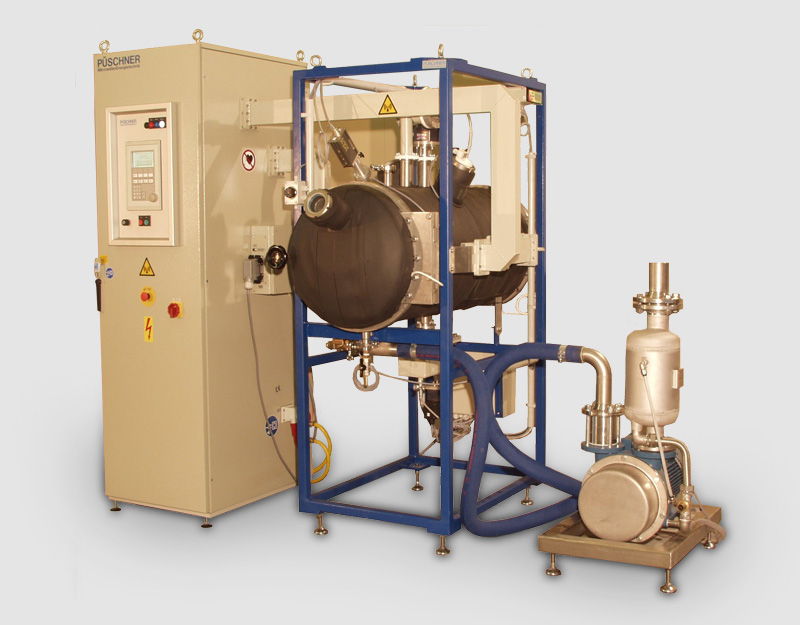
| Dimensions Vacuum Chamber / Operation Mode | Ø 0,5 x 1m Batch |
|---|---|
| Microwave Power | 1,2 - 6 kW / 2450 MHz |
| Total Dimensions | 1,5 x 2,2 x 1,5 m (w x h x d) |
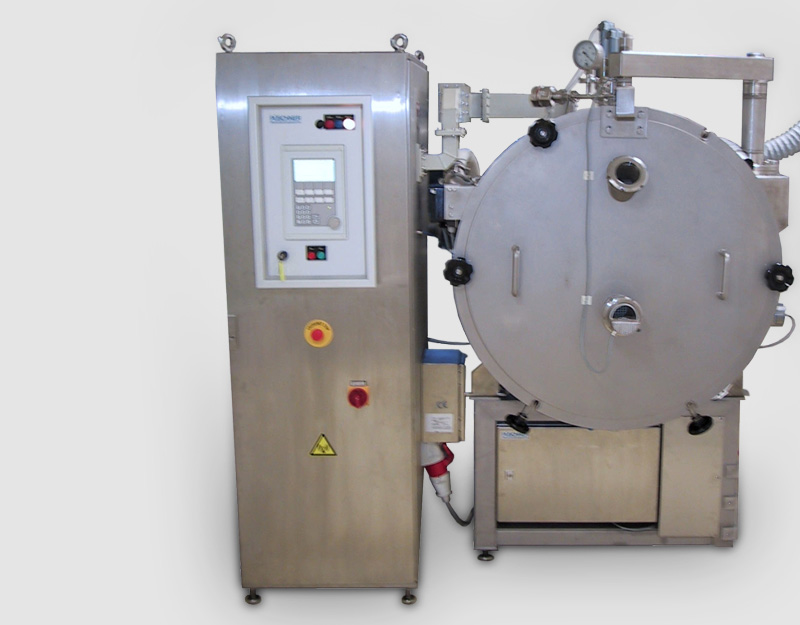
| Dimensions Vacuum Chamber / Operation Mode | Ø 0,9 x 3 m Batch |
|---|---|
| Microwave Power | 1,2 - 6 kW / 2450 MHz |
| Total Dimensions | 2 x 2 x 1,5 m (w x h x d) |
Application examples
µWaveVac0850 using tool carriers for batch operation within a continuous production line
The microwave vacuum dryer µWaveVac0850 was designed and put into operation for gentle drying of thermo-sensitive products. The objective was to dry solid products, such as dialysers, in a continuous mode of operation. The dialysers consist of a plastic shell and internal fiber bundles. Moisture and organic solvent remnants originating from a previous processing step should be removed from the two ends of this product at temperatures below 65 °C, whilst any heating of the dialyser's mid-section is to be prevented.
Legends:
1) transfer system Bosch TS2
2) vacuum pump
3) blocked carriers with product
4) MW-vacuum chamber A (work cycle)
5) carrier entry
6) MW-vacuum chamber B (load cycle)
7) power supply / control box for MW-vacuum chamber
8) control panel PLC control
9) dried product on carriers for further processing
µWaveVac1290 for continuous drying of bulk materials, granulators, filter cakes, powders etc.
Microwave vacuum belt dryers are used for the continuous and automatic drying of temperature-sensitive products with low thermal conductivity such as herbal extracts, food, pharmaceutical and chemical products. The drying process is adapted to the desired dry product quality such as final solids content, solubility, density and others.
Feeding of solids substances is effected by means of a suitably designed feeding device attached with a product orientated metering and distribution set-up in the dryer. When feeding wet products, a metering pump and an oscillating feeder are allocated. The movement of this feeder is adjustable during operation. Therefore, an easy optimising is possible. On two belt stages the products pass different microwave and conventional heating sections, where an appropriate drying profile can be applied to the product to achieve best results.
Advantages
As compared to conventional drying methods, microwaves penetrate into much greater depths. If the penetration depth is bigger than the product dimensions, this is so-called volume heating with the following advantages:
- low temperature drying provides gentle treatment for the product due to low vacuum pressure.
- a temperature gradient directed towards the surface, i.e. temperatures inside are higher than on the outside, giving rise to a pressure gradient which drives the evaporating liquid to the surface
- consequently, the superficial layer does not dry out completely and the surfaces remain permeable
- the liquid evaporating inside the product is emitted through the pore structure of the solid material's macro-capillary system, resulting in a high drying velocity
- the heating of water and most organic solvents occurs selectively - due to the greater dielectric losses of water as compared to the product to be dried
- swift and thorough drying of moist products with low thermal conductivity
- stationary drying of thick layers without frictional losses
- high total efficiency of energy application
- high-speed control of the energy transport
- short processing times, i.e. suitable for automated manufacturing

| Dimensions Vacuum Chamber / Operation Mode | Ø 0,5 x 3,8 m Batch/Conti |
|---|---|
| Microwave Power | 8-16 kW / 2450 MHz |
| Total Dimensions | 2 Batch Plants incl. Transfer System 3 x 2,5 x 17 m (w x h x d) |
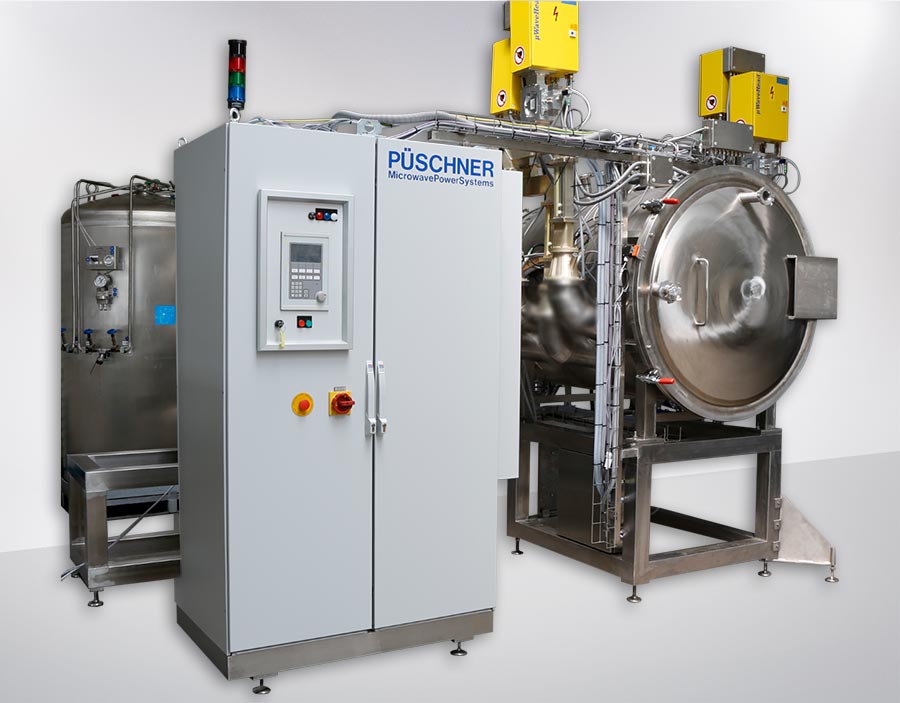
| Dimensions Vacuum Chamber / Operation Mode |
Ø 0,9 x 3 m Conti |
|---|---|
| Microwave Power | 4-12 kW / 2450 MHz 6-30 kW / 915 MHz |
| Total Dimensions | 3 x 4 x 4 m (w x h x d) |




